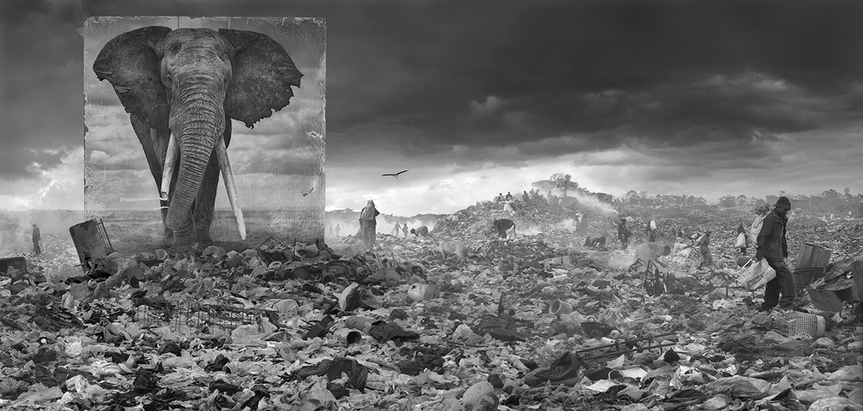
R
E
V N
E
X
T
Today, the world as we know it, in all its splendor and diversity, is a very fragile place. Inherit the Dust the latest monograph by English photographer Nick Brandt, which will be published in March by New York’s Edwynn Houk Editions and distributed by D.A.P. and Thames & Hudson, is a series of panoroma life-size images of elephants, lions, zebras, rhinoceros and chimpanzees erected in places where they once roamed freely, but no longer do. It is in essence an indictment of man’s impact into and destruction of the natural world as a result of rapid and escalating expansion.
Born in London in 1966, Nick Brandt was educated at St. Martin’s School of Art, where he studied painting and film. In 1992 he moved to the United States and began directing music videos with singers such as Michael Jackson and Moby. While directing Jackson’s “Earth Song” in Tanzania in 1995, Brandt fell in love with the country and its fauna. Since then, he has dedicated his life to witness and document the natural world of the East African landscape, in particular, in Kenya’s Amboseli National Park near the Tanzania border.
It was in 2001 that Brandt began in earnest the first of his three part trilogy titled “On This Earth.” Unlike the ubiquitous images commonly found on Discovery or National Geographic channels, Brandt’s images of the animals are far from sensational. Instead they are more akin to an intimate portrait of a subject in a state of calmness and unpretentious majesty. Perhaps this is aided by his insistence and belief in getting as close as he can to his subject without ever using a telephoto lens, in an attempt to reveal its personality. Like a poet rendering an elegy to these beautiful creatures, Brandt’s images are a testament to make their voices heard.
In his afterword for his book On This Earth, Brandt wrote: “To me, every creature, human or nonhuman, has an equal right to live, and this feeling , this belief that every animal and I are equal, affects me every time I frame an animal in my camera.”
For over a decade Brandt has returned to this large ecosystem in Kenya, where he found that the animals he had previously photographed were quickly disappearing. The competition between man and animal for their share of diminishing resources, the rapid urban development, climactic changes and poaching in Africa, all have contributed to this process. Fuelled by the increased demand from China and the Far East, ivory prices have soared from USD 200 per pound in 2004 to more than USD 1,000 a pound in 2013. Annually, an estimated 30,000 to 35,000 elephants are slaughtered across Africa, which represents 10 percent of the elephant population in the world. According to The Atlantic’s report from 2013, rhino horn has seen a resurgence in demand since 2008 particularly in countries such as Vietnam, where it is seen as a virility enhancer, a party drug for the riches, a cure for hangovers and even a status symbol.
In response to the animal exploitation, Brandt directed his energy toward co-founding Big Life Foundation with the renowned conservationist Richard Bonham in 2010 to help preserve the natural world of eastern Africa. Within two years, with its vast network across the Amboseli National Park and its neighbouring ecosystem in the border area between Kenya and Tanzania, and with the help of rangers and aerial monitoring, Big Life was able to reduce in animal poaching in the region and has gained the reputation of being the only organization in East Africa with coordinated cross-border anti-poaching operations. However, as Brandt wrote in his essay accompanying the book Across the Ravaged Land (2013), one of the most critical factors in making the foundation work is through the people who live amongst the animals. Effective conservation can come only with community support and collaboration.
In early 2014, driven by the speed in which many of the unique African megafauna were disappearing, Brandt began his latest series “Inherit the Dust.” Digging into his collection of unpublished animal portraits, he enlarged them to life size and mounted them onto nine-meter-tall panels that he placed in locations that would match with the composition of the original photo and contours of the land. The biggest challenge of course was the wait for the perfect clouds to appear. In almost all of the panorama images appearing in this series, the sombre and melancholic sky add to the feeling of lamentation of what once was.
In conjunction with the publication of Inherit the Dust, a series of exhibition venues are already in place to display these extraordinary photographs. Among them are: Fahey/Klein Gallery in Los Angeles from March 24 to May 14; Camera Work in Berlin from May 13 to July 9; Atlas Gallery in London from May 18 to 22 to coincide with Photo London; and Fotografiska Museum in Stockholm from May 20 to September 11.
Billy Kung is photo editor at ArtAsiaPacific.



